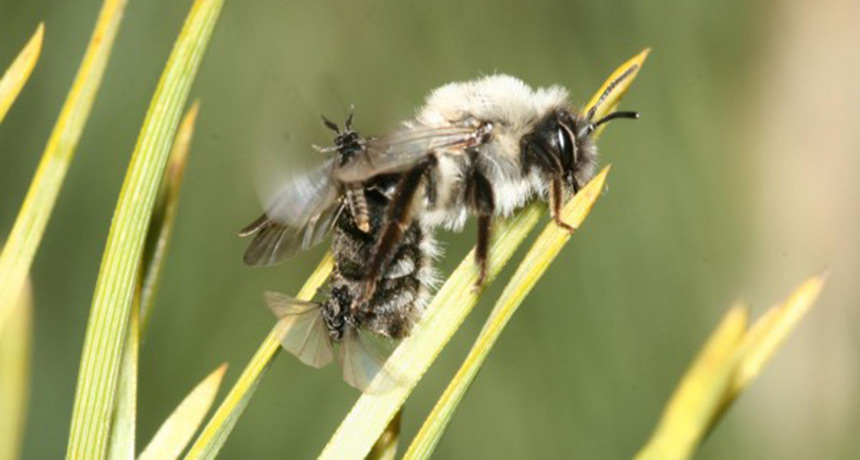The bizarre mating ritual of a bee parasite

The females of Stylops ovinae, a parasitic insect species that lives in mining bees, have pretty dull lives. While the males, tiny winged insects, get to flit about — for a few hours, at least, before they die — the females are literally stuck at home, wedged inside a mining bee for their entire lives with only a bit of their cephalothorax (neck) exposed. And worse, once a female’s offspring hatch, they will eat her alive. Oh, and they’ve got no wings, legs, antennae, eyes, mouthparts or genitalia.
How do those offspring come about if the females don’t have genitals? That’s where this female insect’s life gets even more miserable: To get those cannibalistic kids, she has to first undergo traumatic insemination — a mating in which the male pierces her body with his penis.
Mining bees are common in Germany, and sometimes the bees emerge weeks earlier in the spring than expected; these bees have been infected with parasites. Despite how prevalent the bees and their parasites are, figuring out how the parasites reproduce was no easy task. These insects are tiny and their reproductive systems even tinier. The male parasite’s penis, for instance, is only 0.4 millimeters long.
Scientists have bandied about hypotheses of how S. ovinae might reproduce. With no female genitalia and males once thought to be rare, one idea was that the insects employed parthenogenesis to create more insects. Other researchers posited that the bee parasites did have sex but the males used the same brood canal through which offspring emerged to inseminate the female.
Hans Pohl of the Friedrich Schiller University Jena in Germany decided to take a closer look. They brought mining bees into the lab, imaged the bee parasites with a scanning electron microscope, recorded four parasite mating events and did mating experiments to see how often and how long the insects mated. Their results appear April 29 in Scientific Reports.
A male bee parasite, they found, will attach himself to the bee then stick his penis into the female’s body through her neck. He then hangs on for an average of 8 minutes, and as many as 34 minutes, before taking off. Only a few seconds are actually needed to transfer his sperm, so copulating for so long, the researchers say, could be a way to reduce sperm competition with other males.
By bypassing a female’s reproductive tract, traumatic insemination itself is also a way for males to better ensure that their sperm is the stuff that a female uses to make offspring. And the female parasites may have evolved a way to not be too harmed by the act — they have a little pocket of tissue in the neck area in which the male deposits his sperm, and this may provide a little protection from the trauma of multiple males stabbing her in the neck.